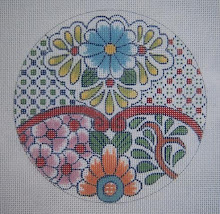 I'll have to do this in two or three installments, as it could get rather lengthy - I intend to show step by step later how to effectively and easily stitch a basketweave background around a shaped ornament. I am seeing people really apparently struggling with it, and making it more difficult than it is.
I'll have to do this in two or three installments, as it could get rather lengthy - I intend to show step by step later how to effectively and easily stitch a basketweave background around a shaped ornament. I am seeing people really apparently struggling with it, and making it more difficult than it is.A really competent finisher can do amazing things with the shaped ornament - I was mentored in this by Vikki Pinson here in Austin, who is fantastic at the art of fine finishing. I had no idea that one could actually have an intricately shaped piece finished without a wide band of background. She finished this cross for me in 1997, and was the first thing I did that was shaped and not on a rectangle.Notice that the background is very narrow - and is a dark purple, which contrasts beautifully with the colors on the cross.
There are two reasons for stitching background on shaped ornaments - one is to provide a seam allowance for the finisher, in which case a bit of it is going to show around the edges. I like to capitalize on this effect and make it a really nice color for edging. Ordinarily, two or three rows of stitching is enough.
I prefer my ornaments very lightly padded with a stiff back - rather than little stuffed pillow looking things, which are awkward and usually puckered around the edges. These look clumsy hanging on a tree or anywhere. For this reason, I add enough background color to show so that nothing is lost from the ornament itself. It's like a framework of color to further enhance the ornament itself.
 This is a picture of Gail Hendrix's blowfish when I was adding the background - just illustrating the enhancing green, and the fact that the outline is added in three rows all the way around. (since it's stitch painted.)
This is a picture of Gail Hendrix's blowfish when I was adding the background - just illustrating the enhancing green, and the fact that the outline is added in three rows all the way around. (since it's stitch painted.) The "jeweled" fish is my own design - an old one from my antique jewelry adaptation phase. Notice the dark green outline - it follows the shape of the fish closely, and showed up well on the finished piece as a colorful and enhancing outline on the edge. By doing this "background," no stitches from the fish itself were lost, and the shape was maintained.
The original piece of jewelry was red and green - so I changed it to blue, as I didn't want it to look like "Christmas."


The other reason for stitching background around an ornament is to give it a bit of added dimension - as sky or water or just a color to enhance the design itself.
The palm tree and parrot could have been stitched with less background and more nearly the shape of the design, but I wanted the color and definition a bit larger.
Again, here is the jewelry from which I adapted the parrot.

The starfish could have been left with only the darker green background, but I wanted the "sea water" also around it for more color. I'll add another chapter to this in a day or two, and deal with the actual stitching how-to of proper basketweave around a shape. It's actually quite simple if you've been taught correctly.
Meanwhile, also check out the other blog (Freebies, etc.), as I have some small crosses there I found that were drawn years ago for individual personal prayer cushions. People have been asking for patterns and ideas for these lately.
ADDENDUM: While looking through my bead files a little while ago, I found this small starfish ornament I made for Vikki several years ago. I can see where I painted out the outline I had originally made for the background, as she said she only needed a few rows for finishing.

You can see how intricate the outline is, and how effective it is to leave the ornament in it's actual shape. It finished quite well as a starfish with hardly any background showing. (This one was done with my technique which makes it look beaded solid.)




3 comments:
Wonderful mini-tutorial, thank you!
The stitched ornaments are delightful! I would like to see them featured on Ornaments.com.
Hi Judy,
I'm so glad that you wrote this tutorial as this is something that I've been doing for years!
I started doing this as I was frustrated that part of a design would be lost during the finishing.
I also like having a border around the design as it shows off the design so much better. This is like leaving part of the linen around a stitched project when framing or like adding a mat to a framed project.
An additional border can add so much to a project!
Cynthia
Windy Meadow
Post a Comment